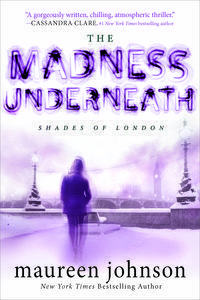Author R&R with Maureen Johnson
 Author Maureen Johnson has written several young adult novels, including The Name of the Star, nominated for an Edgar Award in 2012 for the Best Young Adult title. She's also worked with Electronic Arts as the screenwriter for the handheld versions of the Harry Potter and the Half-Blood Prince video game and earned an MFA in Writing from Columbia University. The Name of the Star was the first in her Shades of London series and followed the exploits of Rory Devereaux, an American girl in London who crosses paths with a band of ghost hunters and gets involved in a string of a brutal murders breaking out over the city that mimick Jack the Ripper.
Author Maureen Johnson has written several young adult novels, including The Name of the Star, nominated for an Edgar Award in 2012 for the Best Young Adult title. She's also worked with Electronic Arts as the screenwriter for the handheld versions of the Harry Potter and the Half-Blood Prince video game and earned an MFA in Writing from Columbia University. The Name of the Star was the first in her Shades of London series and followed the exploits of Rory Devereaux, an American girl in London who crosses paths with a band of ghost hunters and gets involved in a string of a brutal murders breaking out over the city that mimick Jack the Ripper. The second book in the series, The Madness Underneath, was just released and continues the exploits of Rory and the Shades—the city’s secret ghost-fighting police—as Rory tries to recover from the trauma she suffered in the first book (one reason you may want to read it first). Using the same mix of historical, contemporary and paranormal elements as in the first book, The Madness Underneath plunges Rory into a string of new inexplicable deaths threatening London.
The second book in the series, The Madness Underneath, was just released and continues the exploits of Rory and the Shades—the city’s secret ghost-fighting police—as Rory tries to recover from the trauma she suffered in the first book (one reason you may want to read it first). Using the same mix of historical, contemporary and paranormal elements as in the first book, The Madness Underneath plunges Rory into a string of new inexplicable deaths threatening London.
Maureen stopped by IRTM to take some "Author R&R" about how she researched and developed the plots, characters and settings for The Madness Underneath:
The Shades of London books are really
about London, in many ways. The city is a character, of sorts. Much of the
books are about the London that can’t always be seen: the past, the
underground, the secret services. Getting it right was vital.
I spend a lot of time in London, and I made sure I knew the
East London neighborhood where the story mostly takes place. I did Ripper
tours, then I worked on my own with maps and books. I researched underground
tunnels—everything from the actual Underground, to sewers, to shelters, to
graveyards and escape routes and (now known) secret bunkers. I walked miles and
miles. I took pictures of walls and doorknobs and tiles. I watched footage of
what it’s like to drive a Tube train, and I traced the development of the sewer
system on foot.
And, for the first book, I did a lot of research on Jack the
Ripper. I was trying to think of the person you would least want to return from
the grave and roam London, unseen. And the person that sprang directly to mind
was Jack the Ripper.
Jack the Ripper. The name means Victorian England. It means
foggy streets, and carriages, and the glint of a silver knife. It was a story I
was fascinated by as a child. It was a real life mystery, like in the books.
There’s something almost romantic about Jack.
This, when you think about it, is one of the most disturbing
things possible. It would be exactly like saying there’s something romantic
about Ted Bundy or Charles Manson.
The fifth murder of the Ripper series, the murder of Mary
Kelly, is still considered one of the worst crime scenes in English history.
The real mystery is---why is this man famous? He murdered
prostitutes, women who barely registered on the Victorian social scale. He
worked in East London, a place that was rife with murder. It genuinely does not
make sense that this man should be an object of interest for over a hundred
years.
So that’s where the mystery started for me—why Jack? Why do
we care?
The answer might be found in an incredibly boring fact. Up
until 1855, there was a stamp tax on newspapers in England, making them far to
expensive for many people to buy. Once that tax was abolished in that year,
there was a surge in activity. Now everyone could afford a paper. One of the
papers that popped up was called The Star, and the Star knew a good story when
it saw one. Jack the Ripper was a creation of the media. Yes, there was a
Whitechapel murderer, but truth be told, no one quite knows how many people he
killed. It could have been four, or six, or more. (The canonical five are the
five most likely victims, bearing certain signature injuries.) The publishers
of The Star newspaper first saw the
huge potential in the story, pumping it daily, adding frightening drawings.
They were likely the ones who coined the name Jack the Ripper (this is one of
the reasons my book is called The Name of
the Star).
Jack the Ripper is a story based on fact, but the lines
between fiction and reality are blurry. The Scotland Yard case files are
surprisingly paltry. Almost no evidence is still available for examination. The
culprit is most assuredly dead. But what we have left is the fear, so carefully
cultivated by the editors of that newspaper. The fear is so well drawn, it
doesn’t die. Jack the Ripper became part of a collective imagination.
After 123 years, people are still trying to catch Jack the
Ripper. The investigation has never stopped, not once. Even though this guy is
clearly dead, people are still trying to find him. Jack the Ripper has armies
of people investigating his case, filling in the gaps in the files, recreating
the scenes. And since someone solves the case every year or so, there’s always
a documentary to watch, another story to tell. People have been giving Jack the
Ripper the Wikipedia treatment since 1888. And it was from this point of fact
that I started my story, and put the killer back on the streets of East London.
I started to look at things like the London CCTV network,
which is one of the most extensive in the world, with an estimated 1-4 million
cameras, a number that grows all the time. It’s difficult to do anything in
London without being seen, if only by a camera eye. Mostly, though, I thought
about how we would cover the event now. Imagine the frenzy if Jack was back and
we knew what to expect, but not where. London would be prisoner. The media would cover ever second, and the
murder searches would be broadcast live. There would be Ripper Parties, where
people gathered indoors together because you couldn’t be on the streets. At
home, people would be in front of their televisions or computers, watching and
waiting.
So to nail these details, there was a lot of reading. The
main Ripper case file isn’t that extensive. But pretty much all the press is
also available, and you could read that for a week. And that, in many ways, is
where the Ripper legend can be found.
By the end of all of this, I was a walking, talking database
of random facts about trains and sewers and murders—and normally that makes you
a weirdo. Luckily, though, I can do this sort of thing for my job.
For more information on Maureen visit her at www.maureenjohnsonbooks.com or follow her on Twitter via @maureenjohnson. (FYI, Maureen was named one of Time magazine¹s top 140 people to follow on Twitter.)





In Reference to Murder
- B.V. Lawson's profile
- 201 followers



